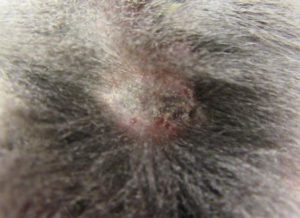
This month we are recognizing two adorable young cats that contracted ringworm. The name ‘ringworm’ is somewhat of a misnomer in that it is not a worm nor does it always form a ‘ring’ pattern. These skin lesions are caused by a fungal organism [Microsporum spp or Trichophyton spp] that affects the top layer of the skin. The fungal spores are ubiquitous – meaning pets can pick them up from the environment, from shared grooming products, from other pets that might be carrying the spores, and yes, occasionally from people who have ringworm lesions themselves.
Ziegfeld and his sister Zola were evaluated at Hawthorne Hills Veterinary Hospital shortly after being adopted when both developed skin lesions around their head and neck. Initially, ringworm infections may look insignificant; just a little area of some dander and missing fur. However, as the infection progresses in dogs and cats, the patient develops larger scaly and patchy areas; the fur typically falls out and if they chew or rub at these areas the skin can look red and irritated.

Many skin lesions can look similar so it is important to get a proper diagnosis to ensure that the treatment plan is correct. Bacterial infections often clear up quickly with antibiotics. However, patients with underlying allergies and fungal infections such as ringworm can be very challenging. Ringworm in particular can be difficult to eliminate from the patient and also from the environment (home). Proper treatment is essential to prevent re-infection and also zoonosis – transmission to people.
Diagnostic testing for fungal infections involves:
- Collecting skin scrapes and looking under the microscope for organisms – mites, bacteria, fungal hyphae or spores that help explain the cause of the skin lesion.
- Wood’s light evaluations – some fungal organisms will fluorescence bright apple green under a special lamp that emits light in a specific wavelength. If the skin lesion doesn’t fluoresce it doesn’t rule out fungal infections so other testing may be needed.
- Fungal cultures (which may take as long as 3-4 weeks for results) – is a way of growing the fungal organism and can confirm exactly which organism is present.
- In complicated cases, it may be necessary to collect skin biopsies.
- A newer test option is submitting samples for PCR (polymerase chain reaction) testing. PCR detects the DNA from any fungi that are present on the skin – however it doesn’t distinguish between organisms that are dead or just on the skin versus those that are actually causing disease.
 Treatment for ringworm is focused on eliminating the infection from the pet and reducing/eliminating the spores in the environment. For the pet we use a combination of oral antifungal medications, medicated shampoos or dips, topical lotions, ointments or cleansers, and sometimes we need to shave the fur to decrease the adherence of spores. [Persian cats seem to be more commonly affected and can often be asymptomatic carriers so eliminating ringworm in this population is especially difficult]. Treating the house and environment requires diligent cleaning, disinfecting, vacuuming and laundering items that have been exposed and must be repeated for as long as the pets are positive.
Treatment for ringworm is focused on eliminating the infection from the pet and reducing/eliminating the spores in the environment. For the pet we use a combination of oral antifungal medications, medicated shampoos or dips, topical lotions, ointments or cleansers, and sometimes we need to shave the fur to decrease the adherence of spores. [Persian cats seem to be more commonly affected and can often be asymptomatic carriers so eliminating ringworm in this population is especially difficult]. Treating the house and environment requires diligent cleaning, disinfecting, vacuuming and laundering items that have been exposed and must be repeated for as long as the pets are positive.
Treatment plans for individual pets will vary depending on the species of fungi (dermatophyte) affecting the patient, the pet’s overall health, the extent of lesions, the number of patients to be treated (sometimes every pet in the household), the pet’s lifestyle (indoors or outdoors) and the response to treatment. It is also important to consider the health of the people residing in the house as immunocompromised people are at higher risk of being infected themselves. The fungal spores can remain infective in the environment for a year or longer which makes this a challenging disease to overcome.
 If your pet has skin lesions that are persistent or you are wondering if they could have ringworm, don’t delay; seek the help of our skilled veterinary team, make an appointment and ensure that your pet is getting the care they need.
If your pet has skin lesions that are persistent or you are wondering if they could have ringworm, don’t delay; seek the help of our skilled veterinary team, make an appointment and ensure that your pet is getting the care they need.
For additional information:
Ringworm in Animals
Environmental Decontamination of Ringworm

